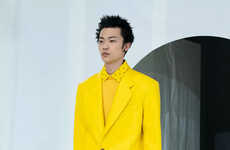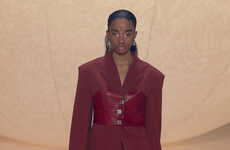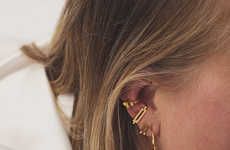
Mame Fall 2018 Draws Inspiration from Traditional Japanese Fashion
Designer Mailko Kurogouchi embraced traditional Japanese fashion for Mame's Ready-to-Wear Fall 2018 collection. The capsule features a heavy use of silk fabrics, intricate embroideries, kimono silhouettes, as well as an interesting palette that "ranged from indigo and mint green to taupe and tobacco," as WWD describes.
The fashion house drew inspiration from Charlotte Perriand—a pioneer in the fashion design industry and "the first woman designer to spend time in Japan." Maiko Kurogouchi's robust and dreamy silhouettes are informed not only by traditional Japanese fashion, but also through the country's arts and crafts. To balance the old with the new, Mame used accessories such as a stylish transparent bag to provide a noticeable juxtaposition to the heritage-inspired Asian elements in the ready-to-wear collection.
Photo Credits: Indigital.tv / Hera Seoul Fashion Week
The fashion house drew inspiration from Charlotte Perriand—a pioneer in the fashion design industry and "the first woman designer to spend time in Japan." Maiko Kurogouchi's robust and dreamy silhouettes are informed not only by traditional Japanese fashion, but also through the country's arts and crafts. To balance the old with the new, Mame used accessories such as a stylish transparent bag to provide a noticeable juxtaposition to the heritage-inspired Asian elements in the ready-to-wear collection.
Photo Credits: Indigital.tv / Hera Seoul Fashion Week
Trend Themes
1. Traditional Japanese Fashion - Exploring traditional Japanese fashion and incorporating it into contemporary designs to create a unique aesthetic.
2. Silk Fabrics and Intricate Embroideries - Utilizing silk fabrics and intricate embroideries to add a luxurious and refined touch to fashion collections.
3. Mixing Heritage and Modern Elements - Combining traditional Asian elements with modern accessories to create a visually striking contrast in fashion designs.
Industry Implications
1. Fashion Design - Incorporating traditional Japanese fashion and techniques into contemporary clothing designs for a unique and attractive product offering.
2. Textile Manufacturing - Producing high-quality silk fabrics and intricate embroideries to meet the growing demand for luxury fashion.
3. Accessory Design - Creating modern accessories that complement and contrast with traditional fashion elements, offering new and exciting options for consumers.
6.4
Score
Popularity
Activity
Freshness























